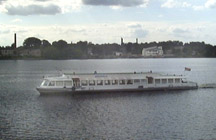Port
of Call: Riga, Latvia
By Michael Leo
 |
| Water
is still a major mode of transport in Riga, Latvia where the
Daugava River meets the Baltic Sea. |
Imagine you lived in a charming
little seaside village at the mouth of a great river. Your
waterfront lifestyle leaves little to be desired; you fish, paddle a
nimble canoe, and enjoy sunsets on the beach with your lovers and
neighbors alike. Then, one day a group of Germans roll into town.
They call themselves the "Brotherhood of the Sword" and
you are curtly informed, as Germans are wont to do, that you are now
part of their new colony and that everything belongs to them. Forget
about Jesus, what would you do? After the joke started to
wear thin, you would kill them, of course. Every last one. That is
exactly what the indigenous residents of what was to become Riga,
Latvia did in the 10th century. However, for the next thousand
years, they were not as successful in the implementation of their
conflict resolution skills. The Germans were only the first
uninvited guests, followed by the Swedes, the Lithuanians, and
eventually the Russians.
Ensconced in a large bay on the
eastern shores of the Baltic Sea, the city of Riga, the birthplace
of the first decorated Christmas tree, grew to be a major trading
and manufacturing center, rivaling St. Petersburg and Moscow. Often
lumped together with its Baltic sisters, Estonia and Lithuania, and
quickly forgotten, Latvia finally achieved independence, the first
time, after World War I, but it was graciously awarded to the
Russian sphere of influence by the Nazis as part of the
Hitler-Stalin Pact. Later, when Hitler turned on Stalin the Nazis
controlled Latvia until 1944 when the Russians reoccupied the
country. After such treachery and enormous losses in the war, the
Russians were not in the best mood when dealing with locals as they
moved westward towards Berlin. Knowing this, almost 100,000 Latvians
fled with the retreating German army. Latvia gained independence
from the glorious Soviet experiment in genocide oppression a second
time on September 6, 1991.
One steady staple for staying warm
on the Riga waterfront is Black Balsam, a thick, alcoholic bitter
made of 16 grasses, oak bark, ginger linden, and other secret
ingredients. This pungent sludge is often mixed with equal part
vodka for an effective hit against any problems, real or imagined.
Riga also serves as a terminus for a major ferry crossing to
Stockholm, operated by the Baltic Kristina. Riga, you can get there
from the San Francisco Bay in 37 days traveling at 10 knots, by way
of the Panama Canal, Cape Wrath, and Skaw, only 9,034 miles.